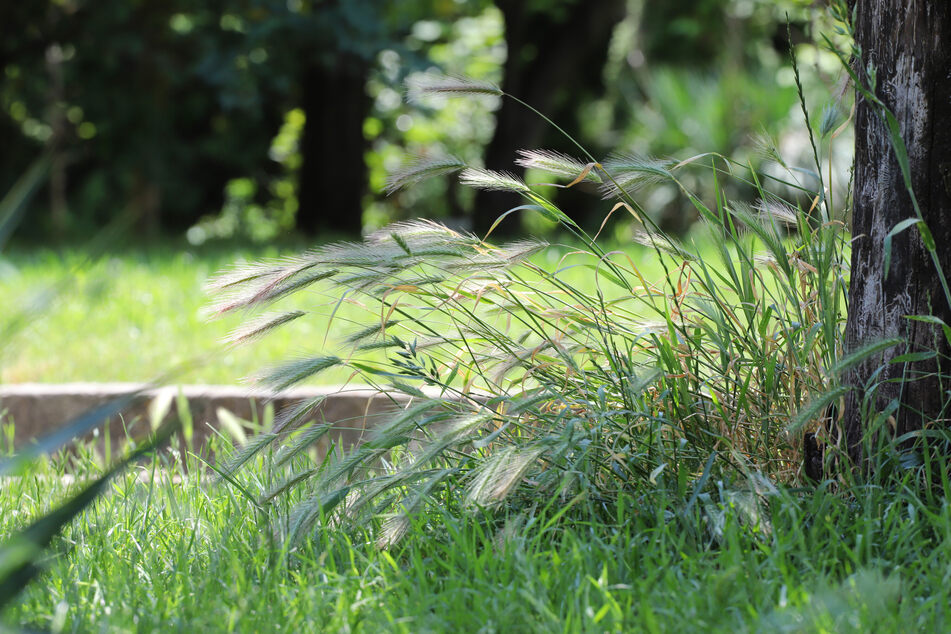Dogs love frolicking through meadows and fields. What many don’t realize is that serious dangers can lurk in these outdoor adventures. iHugDogs reveals the potential harm that foxtails can cause in dogs.
There’s nothing better than a leisurely walk with your dog on a beautiful sunny day. While Bello happily sniffs around meadows and fields, an unexpected danger may be lurking. Whether it’s summer or autumn, a foxtail in a dog can turn into a real problem.
The thread-like plant can quickly burrow into a dog’s nose, ear, eye, or paw, where it becomes embedded. While larger plant parts are visible to the naked eye, a smaller foxtail in the nose may go unnoticed by the owner.
Foxtails in dogs can cause a variety of issues without the owner even knowing where they originate. If not addressed promptly, a foxtail can, in the worst-case scenario, lead to the dog’s death. Therefore, there are several things to consider during a dog walk.
Learn about what a foxtail looks like, the problems it can cause, and how to deal with it.
If your dog shows symptoms of illness or you suspect they’ve sniffed a foxtail, you should visit a veterinarian immediately!
Quick Facts:
- Foxtails are found in meadows, fields, and along paths.
- They can burrow into the nose, eyes, ears, paws, and fur.
- Dogs can swallow foxtails.
- Foxtails lead to serious injuries.
- They can be removed from the fur by the owner.
- A vet visit is urgently required for symptoms.
- Foxtails can lead to the death of the dog.
Foxtails – a Danger for Dogs: Where to Find These Plants?
The term “foxtail” refers to the awn of a grass spikelet. This can be from cereal or sweet grasses. The tips of the plant are not only bristly and hard but also have numerous barbs. Depending on the type of plant, foxtails can be found in grain fields, meadows, or even in the forest. While wheat awns grow upward, sweet grasses quickly bend toward the ground. Therefore, the risk of a dog sniffing a foxtail is even greater. The following plant species have foxtails:
- Barley
- Sweet grasses
- Wheat
- Rye

Are Foxtails Only Found in Summer?
Foxtails bloom in late spring. Although the plants peak in summer, dried specimens can cause trouble well into autumn. While dried awns have fewer barbs, they can still burrow into a dog’s nose, ear, or eye. Special caution is required along paths, where the narrow awns are less noticeable when passing by.
My Dog Has a Foxtail – What to Do?
In case of doubt, always go to the vet! A foxtail in a dog can quickly lead to severe consequences. But how do you know if the dog has come into contact with a foxtail?
First Aid Measures for Foxtails in Dogs:
If a foxtail is caught in the dog’s fur, it can be gently pulled out. Since foxtails have barbs, this should always be done with great care. If necessary, the foxtail, along with the fur, can be cut with scissors. Is the foxtail on the dog’s paw, it can be removed by the owner.
If the foxtail is not superficial on the fur or is in the eye, nose, or ear of the dog, you should go to the vet immediately. Only there can the foxtail be removed professionally, preventing additional injuries to the dog. If you are unsure whether the dog has picked up a foxtail:
Signs of Foxtails in Dogs:
- Rubbing the nose
- Inserting the paw into the nose/ears/eyes
- Rubbing the head/ears on the ground
- Gnawing at the paws
- Snorting
- Labored breathing
- Constant sneezing
- Runny nose
- Watery eyes
- Constant head shaking
- Limping
- Whining, panting, barking, restlessness
If the dog has swallowed a foxtail and is wheezing, immediate danger of choking exists, and you should seek a vet or emergency clinic immediately!
What Happens at the Vet When the Dog Has a Foxtail?
Upon arrival at the vet, they will thoroughly examine the dog. While a small camera can be used to check the dog’s ears deep into the ear canal, an X-ray is needed when there’s suspicion of problems in the nose. In case of unclear symptoms or potential foxtail ingestion, the vet must conduct various examinations to locate the foxtail in the dog. Following this, the foxtail will be removed, sometimes under anesthesia.
Why is it so crucial to remove a foxtail in a dog immediately? The dangerous plant not only embeds itself with its fine barbs but can also migrate through the dog’s entire body, reaching the heart and lungs. In the worst-case scenario, the dog’s life is at risk.

Protecting Dogs from Foxtails: Things to Consider
Especially dogs with floppy and droopy ears should be examined after every walk where foxtails might be present. Since the barbs of these plants can easily latch onto long and curly fur, owners of dogs with such coats should always be vigilant. If the dog tries to pull the irritating foxtail from the fur, it can also lead to sniffing or swallowing the dangerous plant.
Additional helpful tips against foxtails in dogs:
- Avoid walks near foxtails.
- Stay out of grain fields in summer.
- Avoid the edges of meadows or keep a distance.
- Check and brush your dog after a walk.
- Keep dogs on a leash.
- Visit the vet for symptoms.
Foxtails in dogs can quickly become dangerous. Keep an eye on your four-legged friend and avoid subsequent damage.


